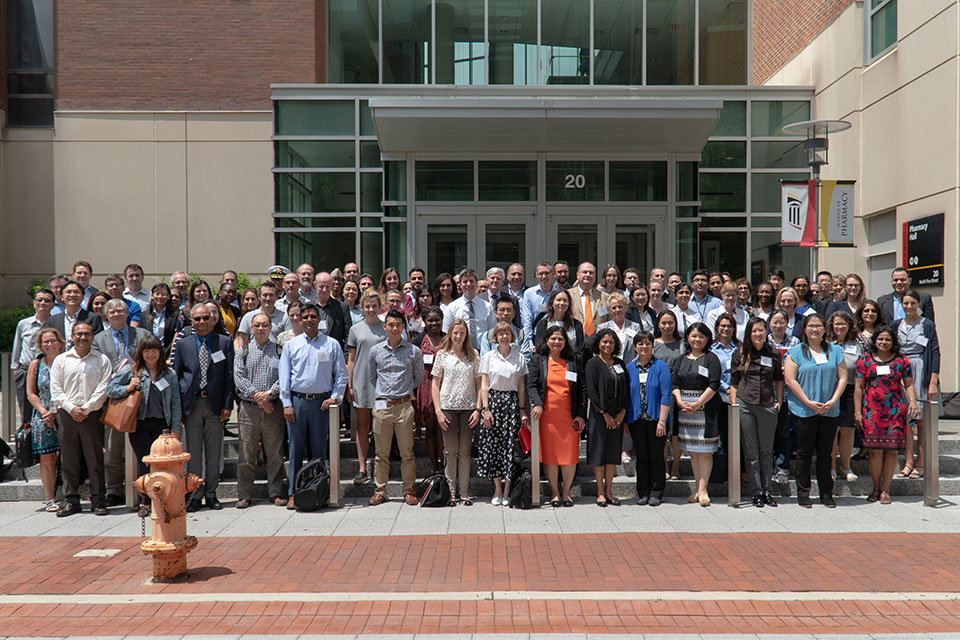M-CERSI Conference Examines Recent Advances in Topical Drug Development
Event sponsored by the University of Maryland Center of Excellence in Regulatory Science and Innovation brings together more than 600 researchers from academia, government, and industry.

By Malissa Carroll
September 10, 2019
The University of Maryland School of Pharmacy welcomed researchers from across academia, government, and industry to Pharmacy Hall in July for “Topical Drug Development – Evolution of Science and Regulatory Policy.” Sponsored by the University of Maryland Center of Excellence in Regulatory Science and Innovation (M-CERSI), the two-day event was attended in-person and online via a livestream webinar by more than 600 participants, and featured a series of presentations and panel discussions that explored the underpinnings of the U.S. Food and Drug Administration’s (FDA) Maximal Usage Trial (MUsT) program, the successful incorporation of MUsT in drug development, and the use of in vitro methods in product development.
“As a topical drug development researcher, one of my goals is to have an impact on the safety and efficacy of products that millions of people use in their daily lives,” said Audra Stinchcomb, PhD, professor in the Department of Pharmaceutical Sciences (PSC) at the School of Pharmacy and co-organizer of the conference, in her opening remarks to attendees. “This conference promises to be a wonderful experience that will not only help me achieve a longstanding professional goal, but also allow us as investigators to continue to advance the science behind topical drug development. I am very excited to host this conference at the School of Pharmacy, and I look forward to a lot of meaningful discussions surrounding this important topic.”
A lack of sufficient analytical models and standardized assessment protocols previously made it challenging for researchers to measure how substances are absorbed into the skin. In the 1990s, the FDA developed the MUsT program to assist researchers in evaluating a product’s in vivo (within a living organism) safety by directly assessing plasma levels following the topical application of the product, as well as to provide information on the effects of disease and formulation on a product’s ability to penetrate the skin. Although initially only used in the development of new prescription topical products, the FDA recently expanded the MUsT program to encompass the development of over-the-counter products following increased scrutiny of non-prescription topical antiseptics and sunscreens.
This conference aimed to explore how information obtained from recent MUsT studies, including the FDA’s pilot sunscreen study, can be used to enhance and improve the development of over-the-counter products.
“In the field of clinical pharmacology, dermatology is one of the last great unexplored areas,” said E. Dennis Bashaw, PharmD, senior science advisor in the Office of Clinical Pharmacology at the FDA and co-organizer of the conference. “For many years, we did not have the tools, technology, or analytical methods that would allow us to truly make an impact in this area. Now that we have them and can harness them, this is a place where we can make important advances and contributions to the science.”
The conference kicked-off with a presentation by Sheila Fallon Friedlander, MD, professor of dermatology and pediatrics at the University of California, San Diego School of Medicine, who provided an overview of absorption and skin factors. She discussed how skin functions and matures over an individual’s lifetime, as well as dysfunctions that can occur in the skin to make patients more susceptible to certain risks.
“This conference provides all of us with an opportunity to share what we know, and allows us the chance to jointly work towards the best and safest care for our patients,” said Friedlander during her presentation. “Many of you in attendance today are experts in the technical aspects of drug development, so my goal is to provide you with the information that we dermatologists have and explain how that information impacts the care that we deliver to our patients.”
One of the most eagerly anticipated presentations of the conference was delivered by Murali Matta, PhD, bioanalytical lead for the Division of Applied Regulatory Science in the Office of Clinical Pharmacology at the FDA, who spoke about lessons learned from the FDA’s recent sunscreen study. The goal of the study was to explore whether the active components of four sunscreen products – avobenzone, oxybenzone, octocrylene, and ecamsule – are absorbed into an individual’s circulatory system when a sunscreen is applied under maximum use conditions.
“While our study demonstrated systemic exposure among the most commonly used ingredients under maximal usage conditions, there is still much that we need to learn,” emphasized Matta. “Is systemic exposure apparent after only a single application? How long does it take for these compounds to clear the body? Is there any toxicity associated with these active ingredients? These are just a few of the questions that we still need to examine with additional studies in the future.”
Additional presentations delivered during the conference addressed existing challenges in topical drug development, considerations in topical drug development in the prescription and over-the-counter setting, and in vitro (outside of a living organism) methods and their application in topical drug development. Interactive panel discussions hosted at the conclusion of each day offered an opportunity for attendees to learn more about the different topics presented.
A poster session was also available for attendees to explore during the conference to further stimulate discussion and interactions among researchers from academia, government, and industry.
“Our goal for this conference was to present a comprehensive look at recent advances in the field of topical drug development,” said Bashaw. “We wanted to provide a forum for discussion to highlight the progress made in regulatory policy and what we see as the future of dermal absorption. We hope that you found the presentations and discussions engaging, and we plan to follow up on the ideas that have been presented here in the near future.”



